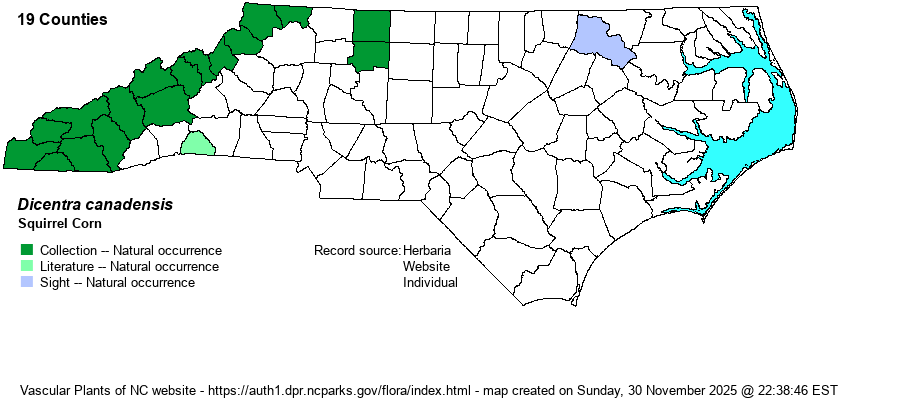| Author | (Goldie) Walpers | |
| Distribution | Throughout the Mountains; ranges east to the western Piedmont (Stokes and Forsyth counties) and disjunctly to the Roanoke River floodplain (Halifax County), in the far northern Coastal Plain. In VA it occurs eastward throughout the southeastern Piedmont.
This is a Northern species, ranging from eastern Canada south to much of VA, extreme northern GA, and MO. | |
| Abundance | Locally fairly common in the Mountains, outnumbered there by the similar D. cucullaria. Very rare and local farther east. Perhaps extirpated from the Halifax County site, though D. cucullaria is still common there, and thus it could easily be overlooked among that species when not in bloom, as the foliages are essentially identical. Both species can be abundant on a given montane slope. | |
| Habitat | This is a characteristic species of Rich Cove Forests, and it also grows in Northern Hardwoods to a lesser extent. It grows in Basic Mesic Forests farther eastward. All sites must have circumneutral soil. | |
| Phenology | Blooms in April and May, generally about two weeks later than does D. cucullaria at the same site. Fruits mainly in June, and disappears completely right after fruiting (i.e., by early or mid-June). | |
| Identification | This species and Dutchman's Breeches (D. cucullaria) have identicial growth forms, with only the flowers differing. They each grow to about 8-12 inches tall. They have several basal leaves, each compound (triangular in overall shape), but finely divided into numerous narrow segments and entire margins. The separate flowering stalk, one per plant, is about 6-10 inches tall, about the same height as the tops of the leaves. The handful of flowers are in a raceme, with each flower being white and hanging downward. The flower is about 3/4-inch long with a narrow heart shape, with two rounded lobes at the top, and two flaring corolla lobes at the bottom. D. cucullaria has the flowers also hanging downward, but the two spurs are quite long and pointed (though rounded at the tip), spreading outward and looking like a pair of white pants hanging upside down. Both species are a favorite spring wildflower, especially owing to the unusual flowers, plus their ability to occur in very large stands. Squirrel Corn is named for its yellow corms, whereas D. cucullaria has orange-red corms; these can be found just below the soil surface in the summer, if you don't mind digging around in a rich cove forest. | |
| Taxonomic Comments | None
| |
| Other Common Name(s) | None | |
| State Rank | S4 | |
| Global Rank | G5 | |
| State Status | | |
| US Status | | |
| USACE-agcp | | |
| USACE-emp | | |

